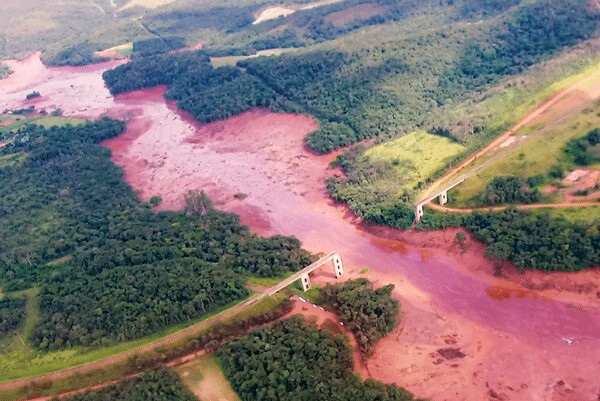Minnesota determined to learn the hard way

For years, critics of the proposed PolyMet copper-nickel sulfide mine have been raising alarms over the safety of PolyMet’s plan to reuse the LTV Steel Mining Company (LTV) tailings basin and dam, citing the instability of what is slated to become a repository for millions of tons of toxic sulfide mining waste.
Foundational instability is only part of the accident-waiting-to-happen picture. The design of the LTV/PolyMet tailings dam is termed an “upstream” construction. Upstream tailings dams have collapsed in British Columbia (at the Mount Polley copper mine), and more recently in Brazil (at the Corrego do Feijao iron mine) near the town of Brumadinho.
Brazil takes action
Reuters described the Brumadinho situation succinctly when it reported, “evidence suggested the dam burst because of liquefaction, a process where solid materials like sand lose strength and stiffness and behave like a liquid.” Further stating, “Vale’s dam in Brumadinho was built using the cheapest and least stable type of tailings dam design, known as an “upstream” construction. Upstream dams are waterlogged and therefore susceptible to cracks that can cause bursts.”
The tragedy at Brumadinho came approximately three years after another mining tragedy in Brazil. Another upstream tailings dam (Fundão) collapsed at an iron mine belonging to Samarco Mineração SA (BHP Billiton and Vale SA). Both mines are located in the Brazilian state of Minas Gerais.
Brazil’s National Mining Agency (ANM) has now banned upstream tailings dams, as has the state of Minas Gerais, requiring that Brazil’s 84 upstream dams be taken down or converted into other types of dams. The ANM stated upstream construction using tailings to raise dam walls could “no longer be tolerated.” https://www.mining-journal.com/politics/news/1356734/brazil-bans-upstream-tailings-dams
Joao Vitor Xavier, state legislator in Minas Gerais, who unsuccessfully introduced similar legislation in 2016 after the Samarco Mineração collapse, told The Associated Press in 2019, “The facts are indisputable: Over 300 people died because these kinds of dams are unsafe. Those who chose to ignore this reality can’t deny it anymore.”
Minnesota chose denial
PolyMet is planning to build the cheapest, least stable type of tailings dam on top of an already unstable foundation. Ignoring reality, Minnesota agencies issued permits for PolyMet.
There has been speculation that Antofagasta (Twin Metals) could consolidate with
PolyMet for processing ore and disposal of toxic waste. Unlikely, considering Chile is one of three countries in the world—along with Peru and now Brazil—that ban upstream tailings dams. Chile banned upstream dams in 1970.
Minnesota’s Department of Natural Resources (DNR) says that it is too early to know what caused the latest collapse in Brazil. Brazil is not waiting around to find out. Upstream dams have been banned; all are to be decommissioned by August 15, 2021. https://www.metalbulletin.com/Article/3858914/Upstream-tailings-dams-banned-in-Brazil-following-Vale-incident.html
Minnesota is doing just the opposite. Barr Engineering and PolyMet claim the old LTV tailings basin is safe. The DNR has issued PolyMet two dam safety permits. It appears the DNR has no interest in reconsidering its decision after the Corrego do Feijao collapse.
Interesting to note that Brazilian authorities have reportedly made 13 arrests in connection with the Brumadinho disaster. Two contract consultants and three Vale employees were arrested days after the tragedy and have since been released. On Feb. 15, authorities arrested eight Vale employees, who remained in prison. As of Feb. 26, prosecutors were seeking the arrest of a Vale SA senior executive.
In Minnesota, who would be held responsible for PolyMet’s flawed Environmental Impact Statement when there is a dam failure? PolyMet, Glencore, DNR Land and Minerals Division, former DNR Commissioner Tom Landwehr, the Minnesota Pollution Control Agency (MPCA), former MPCA Commissioner John Linc Stine, Barr Engineering, a Minnesota Legislature that continually weakens or eliminates mining regulations?
Barr Engineering, the DNR, and PolyMet minimized the danger
PolyMet falsely stated: “The basin has proven to be stable over its 60-year existence; even so, before we put the existing basin back into use, we will incorporate additional engineering controls to ensure it remains stable.”
Not having collapsed does not make it “stable.”
A 1995 Executive Summary of a Sitka Corporation report, one of four phases assessing the stability of the LTV tailings basin, stated that “Weak slimes and peat occur along most of the dam’s face, along four of the geotechnical sections, A, B, E, and F. … the slimes in the dam section are predominantly loose to very loose, indicating low strength under undrained shearing conditions.”
The summary went on to state, “Our undrained strength analysis showed factors of safety at three sections barely above unity. Slimes close to the dam face and clay beneath the peat in the foundation are the primary reasons for the relatively low levels of safety … an extensive flow failure could occur if some mechanism were to trigger liquefaction.”
Further, “Cell 2E raises special concerns. This is where LTV will deposit the bulk of the tailings in the future, it has the thickest and most extensive peat in the foundation, and has slimes close to the dam face.”
A 1997 Executive Summary of the Sitka Corporation assessment additionally stated, “there are continuous zones of slimes under the dam slopes and relatively close to the dam face. This fraction of tailings has the lowest shear strength and the poorest drainage. Where the slimes are close to the dam face, they provide a weak potential failure plane … “
The 1997 summary further stated that “a flow failure could develop almost anywhere along the impoundment perimeter if some event or stress condition triggered liquefaction in the saturated tailings.”

“Willful blindness”
PolyMet spokespeople claim they can reuse the LTV tailings basin by making changes (after permitting), including addition of a rock buttress and additional monitoring stations. PolyMet’s Bruce Richardson told The Timberjay, after the Corrego do Feijao dam collapse, “The NorthMet facility was found to meet every factor of safety for stability.”
The Corrego do Feijao dam at Brumadinho was allegedly certified stable too.
PolyMet’s rock buttress would only be added to the toe of the LTV dam. And monitoring would not stop a structurally unsound dam from sudden catastrophic failure; the Corrego do Feijao dam had 94 piezometers and 41 water level indicators. Ironically, a monitoring well was reportedly being drilled when the Corrego do Feijao tailings dam collapsed in Brazil; there was some speculation that vibrations from the drilling may have triggered the collapse. http://www.wise-uranium.org/mdafbr.html
Richardson also reportedly said, “There are many more active and much-larger iron-ore tailings basins (of similar design) in Northern Minnesota that have existed for decades as well.” https://www.timberjay.com/stories/groups-seek-dnr-stay-on-polymet-dam-permit,14821
In PolyMet’s case, Minnesotans are not talking about decades; we are talking about centuries. I would also remind Richardson that Hibbing Taconite has already had a 1,000-foot crack in its dam. Its tailing basin was built in 1976. Brazil’s Corrego do Feijao basin was built in 1967. DNR Land and Minerals would be wise to expend its limited resources on Minnesota’s aging taconite tailings basins and dams. Not take on PolyMet’s time bomb.
In PolyMet’s case, Minnesotans are talking about the undeniable risk to our waters from catastrophic failure of a tailings dam that was built using the least stable design possible, built on an inherently unsafe foundation; we are talking about the undeniable risk to our health from a release of highly toxic sulfide mining waste.
PolyMet is not a house on a rotten foundation that can be jacked up and the foundation replaced. Fundamentally, the unsound LTV tailings basin and dam can only be braced, shored up with a prayer.
In an era of climate change
How does PolyMet expect makeshift fixes will protect Minnesotans—and Minnesota’s invaluable waters—when 500-year and 1,000-year storm events are becoming the norm? Prevent slimes from becoming saturated with such sudden onslaughts of rainfall? Avoid liquefaction from such rapid increases in groundwater levels? All while also supposedly collecting 99.9% of process-contaminated wastewater, as claimed, and pumping it back into the basin—when the LTV tailings basin was originally designed to leak for stability.
PolyMet is reusing the LTV tailings basin because the company bought the plant site including the tailings basin for the price of scrap. Dry stacking, another option for disposal other than the storage of slurry, could be ten times more expensive then reuse of the basin. If the company were required to build a new tailings basin using a safer design, the resource is too disseminated to be financially worth mining. Reverse osmosis, exceedingly expensive, is also a financial issue for the company, and not surprisingly, there is no guarantee it will ever be used at PolyMet.
Minnesota will be the loser—economically and environmentally—for perpetuity. There will be no returning to what we have today, one of the most incredibly water-rich places on the planet. PolyMet would be the beginning of a sulfide mining range threatening both Lake Superior and the Boundary Waters Canoe Area Wilderness, threatening the health of all those living within the watersheds.
Feb. 20, 2019 photo caption: “Minas Gerais state government said in a statement that blood and urine tests conducted on firefighters searching through muddy mine waste for missing people after a dam collapse show high levels of potentially toxic metals.” https://www.kansascity.com/news/business/national-international/article226760454.html
False reassurance
Financial assurance is not enough; it is false reassurance. Financial assurance will not cover catastrophic failure; that requires liability insurance. PolyMet offered $10 million. Was that ludicrous bottom-line amount the best it could get from a risk-averse insurer? http://queticosuperior.org/blog/polymet-state-agency-disagree-mine-proposals-closure-costs
Upstream dams are not alone when it comes to failure. When will Minnesota’s agencies and our legislators recognize the unbearable risk to our state, to its people? Only after a catastrophic break and collapse occurs in Minnesota? https://www.nps.gov/articles/aps-v13-i2-c8.htm
In Minnesota, in 1976, the Hearing Officer for the Reserve Mining case emphatically stated that an on-land tailings basin must not be located at Mile Post 7. “A 1,000 foot breach in the 13,000 foot south dam at Mile Post 7 would produce a 28 foot high wall of water moving down the Beaver River valley at more than 20 miles per hour to Lake Superior.”
He also warned, “No calculations were made of the additional flow which would result from the movement of tailings with the water. No calculations were made of the effects of a failure of the entire dam.” And he said, “Risk of dam failure would not end when operations cease, but would continue in perpetuity.”
No one listened. Construction began at Mile Post 7 in 1977.
It has been nearly a decade since I testified at a legislative hearing on PolyMet, ending my testimony with, “You cannot clean up what cannot be cleaned up.” It was true then; it is true now.
Now I ask, “What is a human life worth?”
https://www.bbc.com/news/resources/idt-sh/brazil_dam_disaster